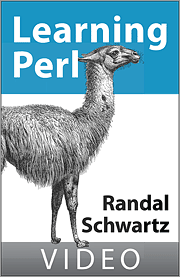The language is intended to be practical (easy to use, efficient, complete) rather than beautiful (tiny, elegant, minimal). Its major features are that it's easy to use, supports both procedural and object-oriented (OO) programming, has powerful built-in support for text processing, and has one of the world's most impressive collections of third-party modules.
If We are looking for video tutorial, that shows us why Perl is the language for people who want to get work done, find out how to use Perl build Lists and Array? How use Perl to read/write file? and more... I mention video "Randal Schwartz on Learning Perl" by Randal L. Schwartz, He is co-author of the bestselling book Learning Perl. This video is useful who interest to be Perl programmer and take to be a Perl programmer. We will learn many ideas(techniques) about Perl on each of topics.
 Video topics include:
Video topics include:- Perl data & variable types
- Subroutines
- File operations
- Regular expressions
- String manipulation
- Lists & sorting
- Process management
- Smart matching
- Using third party modules
We will watch video more than 10 hours and learn(sample):
- Scalar Data: Numbers. Strings. Basic scalar operators. Warnings. Comparison operators. "boolean" concepts. If and while statements. The undef value and defined() function.
- Lists and Arrays: List values. qw() syntax. Array variables. List operations. foreach statement. List and scalar context.
- Subroutines: Defining and invoking subroutines. Return values. Passing arguments. Local variables, including stateful variables. Variable argument lists. Leaving a subroutine early with return(). "use strict".
- Input and Output: Reading an entire file. Filters with and @ARGV. Using printf. Creating and using filehandles. Using die and warn and $!. Using say.
- Hashes: Purpose of hashes. Hash creation and element access. Converting between lists and hashes. The "fat arrow" syntax. Operations on the hash (keys, values, each, exists, delete). Counting things. The %ENV hash.
- In The World of Regular Expressions: Introduction to regex. Simple matching. Simple metacharacters. Simple quantifiers. Parens in patterns. Backreferences (including relative back references). Choice with vertical bar. Character classes.
- Matching with Regular Expressions: Alternate delimiters. Readable regex. Anchors. Binding operator. Interpolating patterns. Match variables. Non- capturing parens. Named captures. Generalized quantifiers.
- Processing Text with Regular Expressions: Substitutions, including global changes. Case shifting. Split and join. List context match. Non- greedy quantifiers. Multi-line matching. In-place editing.
- More...
We can follow Randal L. Schwartz (twitter)(google)



No comments:
Post a Comment